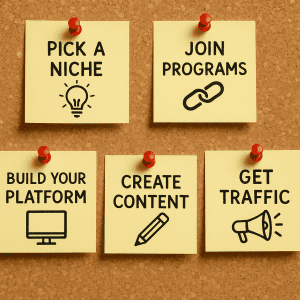Is it Possible?
If you’re sick of scouring the internet for “how to make money online with affiliate marketing” and landing on scams or overhyped rubbish, you’re not alone. Affiliate marketing gets thrown around as the golden ticket, but does it actually work?
So is it possible? Short answer: yes — but not in the way most of the internet makes it sound. Affiliate marketing is a proper business model. It can earn you income, but only if you treat it like a business rather than a lottery ticket.
In this post, I’ll walk you through what affiliate marketing really is, how it works, the steps to start, the pitfalls to avoid, and how to actually make money with affiliate marketing as a beginner.
What Is Affiliate Marketing? (In Plain English)
Affiliate marketing is where you promote someone else’s product or service and get paid a commission when someone buys through your link. That’s it. No product creation, no warehouse, no customer service headaches.
But here’s the catch: it’s not “free money.” You still need to build an audience, create content, and learn how to sell without being pushy.
Think of it like being a digital middle-person: you connect buyers with products they actually want, and you get a slice of the pie when the sale goes through.
How Affiliate Marketing Works (Works Step by Step)
Here’s the simple version of the process:
-
Join an affiliate program — This could be Amazon Associates, a course creator, a hosting company, or any business that offers commissions.
-
Get your unique affiliate link — This is how sales are tracked back to you.
-
Promote that link through content — A blog, YouTube channel, TikTok, email list, whatever platform you’ll stick with.
-
Someone clicks → buys → you get paid — Usually a % of the sale price.
Commissions vary wildly. Some pay a tiny percentage (Amazon), while others (like software or training programs) pay 30–50% or even recurring monthly commissions. That’s where real income potential lies.
Why Affiliate Marketing Works for Beginners
Here’s what makes it appealing if you’re starting out:
-
Earn while you sleep (eventually): Once your content is out there, it can keep making sales without you touching it again. Not instant, but possible.
-
Low start-up cost: No stock. No fancy tools. You can literally start with a laptop, a blog, and your voice.
-
Flexible: You choose what you promote, when you post, and how you show up. Perfect if you’re juggling family or a messy schedule.
-
Scalable: Once your content is live, it can bring in income long after you created it.
That’s why beginners gravitate towards affiliate marketing. But it’s also why people get burned — they expect quick wins
👉 Affiliate marketing isn’t going anywhere. The global industry is estimated to be worth $37.3 billion in 2025 and could reach $48 billion by 2027 – (read more here)
5 Steps to Start Your Affiliate Marketing Journey
Here’s where most guides either get too fluffy or too complicated.
Let’s keep this practical.
Step 1. Pick a Niche You Can Stick With To Start With
Don’t overthink it. You don’t need the “perfect” niche. You just need one you can create regular content about without getting bored. Fitness, finance, parenting, hobbies, side hustles — all work.
👉 Action today: Write down three topics you already talk about with friends or search for on Google. That’s your niche shortlist. Once these are down on paper keep the following in mind as the reason youre doing this is to make money, not just fill pages.
- Passion: Choose a niche you’re passionate about, as this will make content creation more enjoyable. It makes writing posts or making videos a lot less painful.
- Market Demand: Research the demand within the niche using tools like Google Trends or keyword research tools like Uber Suggest.
- Affiliate Programs: Ensure there are reputable affiliate programs within your chosen niche. No point in chosing a dud product to promote as its a sure way to lose out in the long run.
Step 2. Join Affiliate Programs
Not all programs are worth your time. Look for:
-
Fair commission rates (20%+ is decent).
-
Products you’d recommend to a mate.
-
Companies that aren’t going to vanish overnight.
I personally use and learned how to do this with MAP (Master Affiliate Profits), AWeber for email automation, and D9 Hosting , where I host this site . All solid, beginner-friendly.
👉 Pro tip: Use a link cloaker like Pretty Links so your links don’t look like a mile-long mess.
Step 3. Build Your Platform
Your content hub is where the magic happens. For me, it’s this blog. For you, it could be:
-
A WordPress blog (my top pick if you want full control).
-
A faceless YouTube channel.
-
A TikTok account.
-
An email list (start this early).
Don’t try to do everything at once. Pick one and get consistent.
-
Domain name: Buy a domain that reflects your topic.
-
Hosting: Use reliable hosting like D9 Hosting.
-
CMS: WordPress is beginner-friendly once you’re in.
Step 3: Create Engaging Content That Helps People (and Solves Problems)
People don’t Google “affiliate links.” They search “best hiking shoes” or “how to start a blog.” Your job is to answer those questions and naturally recommend products.
Examples of content that works:
-
Blog posts: “How to X” or “Best tools for Y” guides.
-
Product reviews: Honest reviews (warts and all). Readers can smell fake.
-
Videos: Tutorials or demos. Doesn’t have to be fancy — just useful.
👉 Example: Blog post → 5 Game-Changing Tools I Actually Use For Affiliate Marketing with links.
Content is king in affiliate marketing. Focus on creating valuable, high-quality content that resonates with your audience. Don’t just slap links everywhere. Make content that solves a problem or answers a question.
Step 4: Get Eyes on Your Content (Traffic is King)
Content is nothing without traffic. Traffic matters more than anything. To succeed, you’ll need to attract visitors to your content. Creating content is one thing — getting eyes on it is another. Here are some strategies:
- Search Engine Optimization (SEO): Add keywords naturally so Google knows what your post is about. Optimize your content with relevant keywords, meta tags, and internal links to boost visibility.
- Social Media Marketing – Pinterest/YouTube/TikTok/Instagram: Platforms where beginners can still get organic reach. Share your content on social platforms, engaging with your audience to create a buzz around your posts. Join Facebook groups and start conversations.
- Email Marketing: This is gold. Email list: Nurture subscribers and share your recommendations. Give away a free checklist or guide to build your list, then keep in touch. Building an email list allows you to regularly connect with your audience and promote your content.
👉 Best approach: combine one long-term source (SEO or YouTube) with one quicker source (social media).
Step 5: Analyze and Optimize
Nothing’s perfect on the first go. Keep learning what works. To maximize your affiliate marketing success, it’s crucial to evaluate your efforts constantly:
- Track Metrics: Use free tools like Google Analytics to see what’s getting clicks. The ones that matter are where your traffic is coming from, conversion rates, and user behavior.
- A/B Testing: Experiment with different content formats, headlines, or calls-to-action (CTAs) to determine what works best.
- Feedback: Pay attention to what your audience likes — they’ll tell you in comments, clicks, or silence. Listen to the feedback and adjust your strategies accordingly to improve engagement.
The Challenges No One Talks About
Most people quit affiliate marketing within six months. Here’s why:
-
Unrealistic expectations — Believing the “get rich quick” hype.
-
Inconsistent effort — Posting one blog, then vanishing for a month.
-
Chasing shiny objects — Buying every new course or tool.
-
Not building an email list — Relying only on social media platforms that change overnight.
👉 The fix: treat it like a side business. Set weekly output goals (like one blog + one Short) and stick with them.
Common Challenges and Solutions
Challenge 1: Finding the Right Audience
Finding Your People Takes Time: You won’t go viral. And that’s fine. Consider these strategies:
- Engage in Forums: Join niche-specific forums or online communities where your potential audience congregates.
- Utilize Social Media Groups: Participate in Facebook or Reddit groups related to your niche.
Challenge 2: Keeping Up with Trends
Trends shift. Algorithms mess with you. Just roll with it and keep learning. Here’s how to stay updated:
- Follow Industry Leaders: Subscribe to reputable blogs, podcasts, or newsletters that provide insights on digital marketing trends.
- Continuous Learning: Consider taking online courses on affiliate marketing strategies to hone your skills.
Challenge 3: Overcoming Initial Slow Growth
The first few weeks (or months) feel like shouting into a void. Keep going anyway. The content you make today might pay off three months from now. Almost all new affiliate marketers experience slow growth in their early days. Here’s how to overcome it:
- Be Patient: Success takes time; continue to produce quality content consistently.
- Diversify Income Streams: Don’t focus solely on one affiliate program. Explore multiple programs to increase earnings and minimize risk.
Final Thoughts: Can You Actually Make Money with Affiliate Marketing?
Yes — but only if you approach it properly. Affiliate marketing works when you:
-
Pick a niche you can stick with
-
Join solid affiliate programs
-
Create content consistently
-
Focus on helping first, selling second
-
Build an email list early
If you do those, the money follows — usually slower than you’d like, but steadier than you think.
👉 Want to skip the rookie mistakes? Grab my free Affiliate Marketing Mistakes Checklist
OTHER READS>>> Overcome Digital Marketing Overwhelm
Common Affiliate Marketing Questions
Can you start affiliate marketing with no money?
Yes — but it’s slower. A free platform like Medium, TikTok, or YouTube works, but investing in your own blog is the smarter long-term play.
How long does it take to make money with affiliate marketing?
If you’re consistent, you can see results in 6–12 months. But it won’t replace a salary instantly.
Do you need a huge audience?
No. You need a targeted audience. 500 people who trust you is better than 5,000 random followers.
Want no-fluff tips for building your online biz?
If this post gave you a lightbulb moment or a sigh of relief, you're not alone — that's exactly why I started sharing what I've learned.
Pop your name and email below and I'll send you beginner-friendly advice, useful tools, and the truth behind what really works online — straight to your inbox, no pressure.
👇 Sign up below and let's do this together.
Affiliate Note: Some of the links above are affiliate links, which means if you decide to purchase through them, I may earn a small commission — at no extra cost to you.
I only recommend tools I truly believe in and use myself. It helps support my blog and keeps the coffee flowing ☕
💬 Over to You:
What’s one thing you wish someone had told you before starting your online business?
I'd love to hear it — just hit reply to any of my emails and tell me, or share it with me over on my Facebook page. I read every single one.
SHARE – If you found this post helpful, why not share it with someone else who’s figuring it out too?



